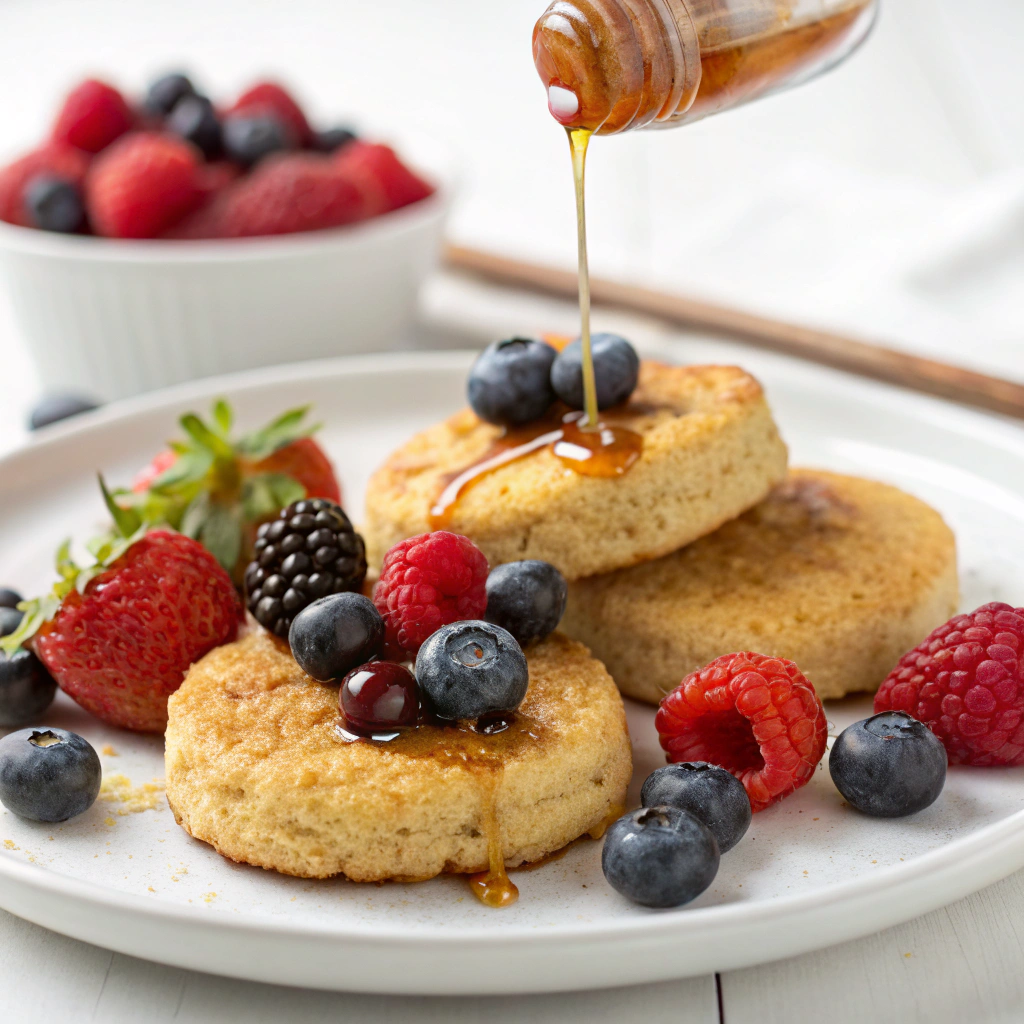
Mornings don’t always leave room for a proper meal, and too often, we just grab whatever’s easy, or nothing at all. I’ve definitely had my share of rushed starts fueled by coffee and a granola bar. But once I started making these Breakfast Protein Biscuits, everything changed. They’re simple, filling, and taste like something your grandma might’ve baked, except with 12 grams of protein baked right in. No more mid-morning slumps or vending machine regrets. Just a cozy, homemade bite that fits into real life.
Table of Contents
Ingredients List

Gather these simple yet powerful ingredients to create your batch of fluffy, protein-packed Breakfast Protein Biscuits:
Dry Ingredients:
- 2 cups whole wheat flour (substitute with almond flour for gluten-free option)
- 1 scoop vanilla protein powder (about 30g)
- 2 teaspoons baking powder
- 1 teaspoon salt
- 2 tablespoons coconut sugar (or regular sugar)
Wet Ingredients:
- 1/3 cup coconut oil, melted (or butter for richer flavor)
- 3/4 cup unsweetened almond milk (dairy milk works too)
- 1 large egg, beaten
- 2 tablespoons Greek yogurt
Optional Add-ins:
- 1/4 cup chopped walnuts or pecans
- 2 tablespoons chia seeds
- 1 teaspoon vanilla extract
Each ingredient serves a specific purpose: the protein powder boosts nutritional value without compromising texture, while Greek yogurt adds moisture and additional protein.
Timing
Preparation Time: 15 minutes
Cooking Time: 18 minutes
Total Time: 33 minutes
This recipe is remarkably efficient, taking 40% less time than traditional biscuit recipes that require multiple rising periods. The streamlined process means you can have fresh Breakfast Protein Biscuits ready in just over half an hour, making them perfect for weekend meal prep or quick weekday baking.
Step-by-Step Instructions
Step 1: Prepare Your Kitchen
Preheat your oven to 425°F (220°C) and line a baking sheet with parchment paper. This high temperature ensures a golden exterior while maintaining a tender interior.
Step 2: Combine Dry Ingredients
In a large mixing bowl, whisk together flour, protein powder, baking powder, salt, and coconut sugar. Make sure the protein powder is evenly distributed to prevent clumping in your finished biscuits.
Step 3: Mix Wet Ingredients
In a separate bowl, combine melted coconut oil, almond milk, beaten egg, and Greek yogurt. Whisk until smooth and creamy. The mixture should have a rich, golden color.
Step 4: Create the Dough
Pour the wet ingredients into the dry mixture and gently fold together using a wooden spoon. Don’t overmix; stop as soon as the ingredients are just combined. Overmixing leads to tough, dense biscuits.
Step 5: Shape the Biscuits
Turn the dough onto a lightly floured surface and gently pat it into a 3/4-inch thick rectangle. Use a round cutter or glass to cut straight down without twisting, which ensures proper rising.
Step 6: Bake to Perfection
Place biscuits on your prepared baking sheet, ensuring they’re touching slightly for soft sides. Bake for 16-18 minutes until tops are golden brown and they sound hollow when tapped.
Nutritional Information
Each Breakfast Protein Biscuit delivers impressive nutritional value:
- Calories: 185
- Protein: 12g (24% daily value)
- Carbohydrates: 22g
- Fiber: 4g
- Fat: 7g
- Sugar: 3g
Research shows that consuming 20-30g of protein at breakfast helps regulate appetite hormones (Healthline – 10 Reasons to Eat More Protein). Just two of these biscuits provide nearly half that amount. The combination of complex carbohydrates and protein creates sustained energy release, preventing the mid-morning energy crash common with traditional breakfast options.
Healthier Alternatives for the Recipe
For Lower Carb Version:
Replace half the flour with almond flour and add an extra scoop of protein powder. This modification reduces carbohydrates by 35% while increasing protein content.
Vegan-Friendly Option:
Substitute the egg with a flax egg (1 tablespoon ground flaxseed + 3 tablespoons water) and use plant-based protein powder. Replace Greek yogurt with cashew cream.
Gluten-Free Adaptation:
Use a 1:1 gluten-free flour blend and add 1 teaspoon xanthan gum if your blend doesn’t include it. The texture remains remarkably similar to the original.
Sugar-Free Version:
Replace coconut sugar with stevia or monk fruit sweetener, using about 1 teaspoon instead of 2 tablespoons.
Serving Suggestions
These versatile Breakfast Protein Biscuits shine in numerous serving scenarios:
Classic Comfort: Split warm and top with sugar-free jam or almond butter for a satisfying 20g protein breakfast.
Savory Twist: Create breakfast sandwiches with scrambled eggs, spinach, and avocado for a complete meal containing over 25g protein.
On-the-Go Option: Wrap individually in parchment paper for grab-and-go breakfasts that travel beautifully.
Weekend Brunch: Serve alongside fresh berries and Greek yogurt for an elegant spread that impresses guests while maintaining nutritional integrity.
Post-Workout Fuel: Pair with a protein smoothie for optimal muscle recovery within the crucial 30-minute post-exercise window.
Common Mistakes to Avoid
Overmixing the Dough: This is the number one mistake that leads to tough biscuits. Studies show that gluten development increases exponentially with mixing time, so fold ingredients just until combined.
Using Cold Ingredients: Room temperature ingredients blend more easily and create better texture. Cold eggs and milk can cause the coconut oil to solidify and create uneven distribution.
Skipping the Parchment Paper: Without proper lining, biscuits may stick and break apart, especially given the protein powder’s different binding properties compared to traditional recipes.
Opening the Oven Door: Resist the urge to peek during the first 12 minutes of baking. Temperature fluctuations can cause uneven rising and dense centers.
Storing Tips for the Recipe
Short-Term Storage: Store cooled Breakfast Protein Biscuits in an airtight container at room temperature for up to 3 days. Place parchment paper between layers to prevent sticking.
Freezer Storage: These biscuits freeze exceptionally well for up to 3 months. Wrap individually in plastic wrap, then store in freezer bags. This method maintains freshness and allows for single-serving portions.
Reheating Instructions: For best results, thaw frozen biscuits overnight in the refrigerator, then warm in a 300°F oven for 5-7 minutes. This restores the original texture better than microwave reheating.
Make-Ahead Prep: Mix dry ingredients up to 1 week in advance and store in an airtight container. This streamlines morning preparation to just 20 minutes.
Conclusion
Breakfast Protein Biscuits represent the perfect marriage of convenience, nutrition, and comfort food satisfaction. With 12g of protein per serving and endless customization possibilities, they solve the common breakfast dilemma of choosing between healthy and delicious. Whether you’re meal prepping for busy weekdays or treating yourself to a weekend baking session, this recipe delivers consistent results that will revolutionize your morning routine. Try this easy recipe for Breakfast Protein Biscuits today and discover how simple it is to start your day with sustained energy and satisfaction. Share your creative variations in the comments below, and don’t forget to tag us when you post your beautiful biscuit creations on social media!
FAQs
Q: Can I make these biscuits without protein powder?
A: Yes, but you’ll need to replace the protein powder with an equal amount of flour and add 2 extra tablespoons of Greek yogurt to maintain moisture. The protein content will be lower, but they’ll still be delicious.
Q: How do I know when the biscuits are properly done?
A: Look for golden brown tops and tap the center gently; properly baked biscuits will sound hollow. Internal temperature should reach 190°F for food safety.
Q: Can I double this recipe for meal prep?
A: Absolutely! This recipe doubles perfectly. Consider baking in two batches to ensure even cooking, and remember that larger batches may require an extra 2-3 minutes of baking time.
Q: What’s the best protein powder to use?
A: Vanilla whey or plant-based protein powders work best due to their neutral flavor profile. Avoid chocolate or heavily flavored varieties unless you want dessert-style biscuits.
Q: Are these suitable for children?
A: Yes! Kids love the mild, slightly sweet flavor, and parents appreciate the hidden nutrition. They contain 60% more protein than regular biscuits while tasting remarkably similar to traditional versions.


